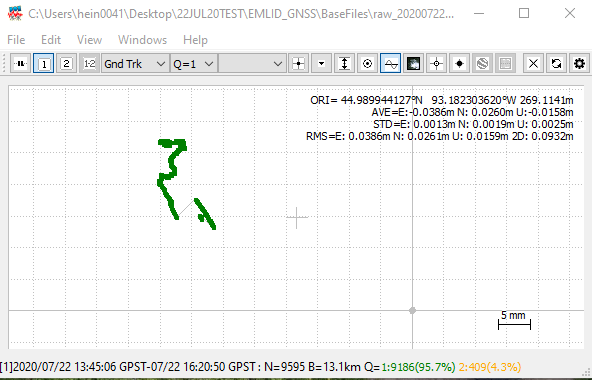I’ve just begun working with the two RS2 units I have. Initial results seem improbable. Basic PPK workflow, 1) Occupy base with 30 min accumulation time, 2) In this case base collected measurements for approximately 3 hrs, 3) power down, 4) download data, 5) download CORS data, 6) Use RTKPOST to correct Emlid using CORS data from station 13km away. Does this look legit?
I am pretty sure you’ll be able to achieve even higher precision with base-rover setup 
Thanks for your reply Dmitriy.
I did shoot some GCPs as check points during this test. Do I understand correctly that you would expect the corrected rover positions to be more accurate than the base it’s corrected against, or are you talking about an RTK workflow?
The other question I would have is which figures would I use for overall horizontal and vertical accuracy?
Yes, it looks entirely legit and reasonable, based on what you’ve shown.
corrected data being under 1cm is the norm. I usually tie into control points with 5-8mm accuracy when using a base/rover setup.
Basically, I’m trying to develop a workflow for UAS PPK processing in remote locations. I’ll just be running a base and correcting against CORS stations 10-40km away. Generally, there is no geodetic control close by, even if there were I couldn’t leave my gear there and go fly somewhere else entirely.
Hey there,
Just want to sum up this topic.
As has been pointed out before, the post-processing results @uas obtained are entirely okay. You can get them by collecting the logs for a considerable amount of time.
Regarding the accuracy, you might want to take a closer look at the values in the Position tab of the RTKPlot. There it’ll be possible to see the STD and RMS values for the E-W, N-S, and U-D directions.
Generally, if you don’t change the solution file, in RTKLib, the STD and RMS values are equal. If you output only the position calculated in Fix (by choosing Q=1), they are not the same. Even though both values are computed for the Fix solution, they use different set average values: for RMS, it is for all of the Solution statuses and for STD - for the Fix solution only.
Welcome to the club! You can get some excellent results from you new pair of RS2s.
Here’s the results I got with mine on three NGS marks (2-hr occupations). Like you, I spent a lot of time thinking they were too good. 
FYI: I know a lot of the online RTKPost materials recommend using the CORS coordinates in the RINEX file header (simple and easy), but the NGS characterizes those coordinates as APPROXIMATE and recommends using instead the coordinates in the station’s coordinates file.
This topic was automatically closed 100 days after the last reply. New replies are no longer allowed.




